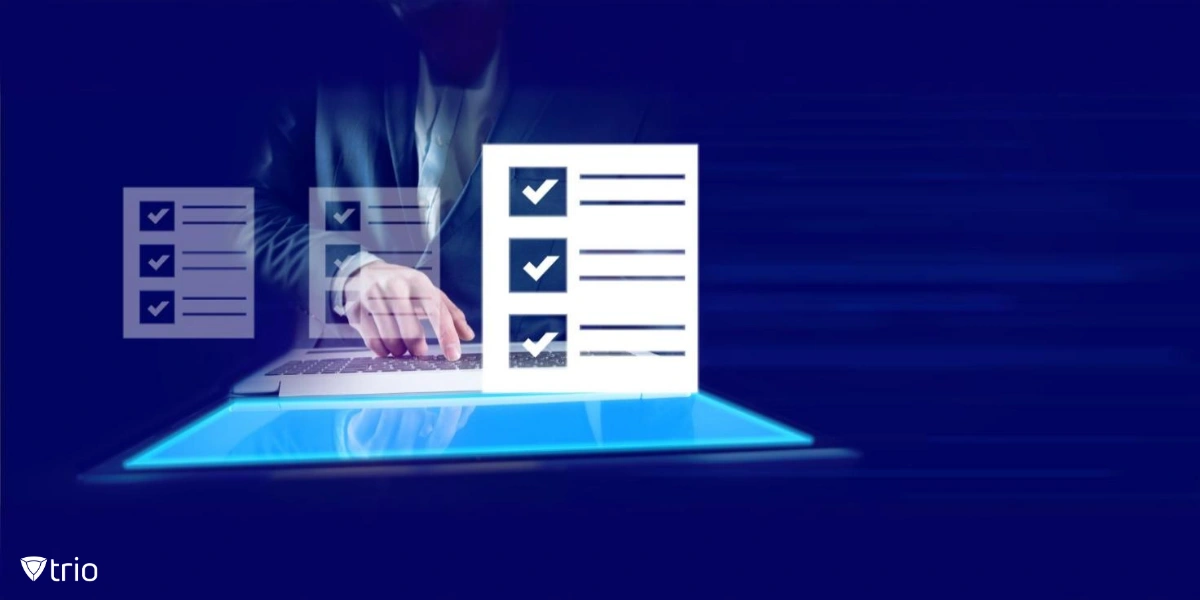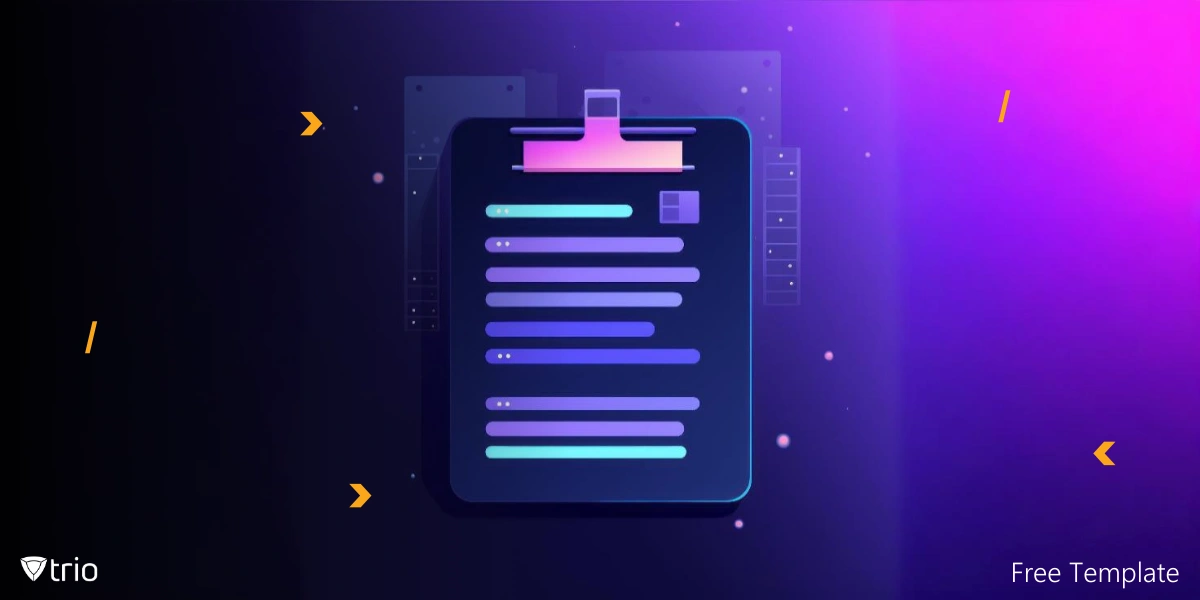An information technology (IT) audit is an essential process for evaluating your organization’s technology systems to ensure they are secure, compliant, and operating efficiently. Whether you’re preparing for an external audit or conducting an internal review, a structured audit schedule and a well-designed ICT audit checklist are key to ensuring a thorough assessment. In this blog, we’ll explore an easy-to-use IT audit checklist template that you can use to evaluate your IT governance, security controls, infrastructure, and more.
What is an IT Audit Checklist?
An IT audit checklist is an essential tool within the internal audit process, specifically designed to evaluate your organization’s IT systems, security measures, operational processes, and policies. It helps ensure that your technology infrastructure is secure, compliant with regulations, and operating effectively. IT audits also highlight areas for improvement, reducing risks and preventing potential breaches.
The process typically includes the review of the organization’s IT governance, security protocols, data protection measures, system performance, and disaster recovery strategies. An IT audit checklist helps streamline this process, ensuring all crucial aspects are covered and nothing is overlooked.

Key Components of an IT Audit Checklist
An IT audit checklist has seven key components:
1. IT Governance & Policy Compliance
- Documented Policies and Procedures: Ensuring that all IT policies and procedures are well-documented and enforced is the first step in an audit. This ensures everyone knows the rules and follows the same guidelines.
- Roles, Responsibilities, and Accountability: An effective IT governance structure should have clearly defined roles and responsibilities, ensuring that accountability is established at all levels.
- Regulatory Compliance: Compliance with regulations like GDPR, ISO 27001, and HIPAA is critical. Your IT systems should adhere to the legal and industry-specific standards for data protection and privacy.
- Risk Management Strategies: Regularly updated risk management strategies are essential to address potential threats. An IT audit should assess whether these strategies are in place and effective.
2. Security Controls & Access Management
- Password and MFA Policies: Strong password policies and multi-factor authentication (MFA) are essential in protecting systems. Regular audits can confirm whether these controls are effectively implemented.
- Access Control Mechanisms: Sensitive data and systems should be protected by strong access controls, ensuring only authorized personnel can access critical resources.
- Firewalls, Antivirus, and IDS: Effective firewalls, antivirus solutions, and intrusion detection systems (IDS) are fundamental security tools. Regular audits should verify that they are up-to-date and functioning as intended.
- Regular Patch Updates: Applying security patches and updates promptly ensures systems are protected against known vulnerabilities. The audit should confirm that patch management is being handled regularly.
- Cybersecurity Training: Employees are often the first line of defense. Regular cybersecurity awareness training is essential for helping staff identify and respond to security threats.
3. Data Protection & Backup
- Data Encryption: Ensuring that data is encrypted both during storage and transmission is crucial for maintaining confidentiality and security.
- Backup Procedures: Regular, secure backups of your data should be performed and stored safely. An audit should check if this process is in place and functioning correctly.
- Data Retention and Disposal: Data should only be retained as long as necessary. Policies for securely disposing of outdated data are essential and must be followed.
- Incident Response Plan: An established incident response plan ensures that data breaches are handled swiftly and efficiently. Audits should verify the existence and effectiveness of such plans.
4. IT Infrastructure & System Performance
- Infrastructure Reliability and Scalability: An IT audit checks whether the hardware and network infrastructure is reliable, scalable, and capable of supporting business growth.
- System Performance Review: Regularly reviewing system performance metrics and addressing bottlenecks is key to ensuring that your systems are running efficiently.
- Cloud and On-Premise Optimization: Whether using cloud resources or on-premise systems, audits ensure that both are optimized for performance and cost-efficiency.
- Software Licensing and Updates: Software should be regularly updated and properly licensed. This helps to prevent security vulnerabilities and legal issues.
5. Disaster Recovery & Business Continuity
- Disaster Recovery Plan: A well-defined disaster recovery plan (DRP) ensures that operations can continue in the event of a disaster. An audit checks the existence and effectiveness of such a plan.
- RTO and RPO: Recovery time objectives (RTO) and recovery point objectives (RPO) should be clearly defined. Regular testing ensures that recovery processes are effective and achievable.
- Disaster Recovery Drills: Conducting and reviewing regular disaster recovery drills ensures your team is prepared for any emergency.
- Redundant Systems and Failover Mechanisms: Redundancy is vital for maintaining operations during failures. Audits verify the presence of redundant systems and failover mechanisms.
6. IT Asset Management
- IT Asset Inventory: Keeping an updated inventory of all IT assets, including hardware, software, and licenses, is essential for managing and protecting resources.
- Asset Decommissioning and Disposal: Outdated or unused assets should be properly decommissioned and disposed of to avoid security risks.
- Asset Lifecycle Management: Proper management of assets throughout their lifecycle ensures that they are maintained, updated, and retired when necessary.
7. Vendor & Third-Party Risk Management
- Contract and SLA Reviews: Contracts and service level agreements (SLAs) with IT vendors should be regularly reviewed to ensure that terms are being met and risks are mitigated.
- Third-Party Security Compliance: Vendors and third parties should be assessed for their security practices to ensure that they meet the organization’s standards.
- Vendor Incident Response Mechanisms: It’s important to confirm that vendors have incident response and support mechanisms in place to handle any potential issues quickly.
Download Our Free IT Audit Checklist
Ready to get started with your IT audit? Download our IT Audit Checklist Template today and ensure your systems are secure, compliant, and ready for the future.
How to Use This IT Audit Checklist
Using this checklist is simple. Start by downloading our template and evaluating each of the categories listed, ensuring that all relevant items are addressed. Customize the checklist to fit your organization’s unique needs, adding or removing items where necessary. Tools such as audit management software can also be used to streamline the process and track results.
How Often Should Your IT Audit Checklist Be Reviewed?
The frequency at which you review and update your IT audit checklist can vary depending on the size of your organization and the complexity of your IT infrastructure. For smaller businesses with a simpler tech environment, conducting an internal audit checklist and reviewing it annually may suffice. However, for larger organizations or those with more complex IT systems, it’s recommended to conduct audits more frequently—quarterly or bi-annually—to stay on top of emerging threats and regulatory changes.
Smaller businesses might focus on critical areas like security, compliance, and basic IT governance, while larger enterprises may require more frequent audits to cover a wider range of systems and processes. Regardless of size, ensuring that the audit schedule aligns with industry standards and evolving risks is essential. Regular updates to the checklist ensure that your organization stays compliant, secure, and optimized.
Benefits of Conducting an IT Audit
Conducting a thorough IT audit using a comprehensive checklist offers numerous benefits:
- Improved Security: Helps identify and address potential security vulnerabilities before they are exploited.
- Regulatory Compliance: Ensures your organization remains compliant with industry regulations.
- Operational Efficiency: Optimizes system performance and resource utilization.
- Risk Mitigation: Helps prevent potential IT failures by assessing risks and taking corrective actions.
Common Pitfalls to Avoid
While conducting an IT audit, there are several common pitfalls to avoid:
- Focusing on One Area: A successful audit should cover all areas of IT, not just security.
- Rushing Through the Checklist: Taking shortcuts can result in missed issues. Be thorough in your review.
- Failing to Update the Checklist: As technology evolves, so should your checklist. Keep it updated to reflect new tools, regulations, and industry standards.

How Trio’s MDM Solution Can Help with Your IT Audit Checklist
Trio’s Mobile Device Management (MDM) solution can be a valuable tool during your IT audit process. With a comprehensive set of features, Trio streamlines many aspects of the audit checklist, especially in areas such as security controls and access management.
For instance, Trio helps enforce strong password policies, multi-factor authentication (MFA), and centralized access control, ensuring that sensitive data and systems are secure. Additionally, Trio provides real-time monitoring of device compliance, patch management, and software updates, helping you stay on top of vulnerabilities and ensuring that your devices are up to date. In terms of IT asset management, Trio automatically tracks all devices, including their configurations, status, and lifecycle, ensuring that your asset inventory is always accurate and up-to-date.
By integrating Trio into your IT audit process, you can not only streamline the audit itself but also maintain ongoing compliance, security, and operational efficiency across your organization’s devices.
Ready to experience how Trio can improve your IT audit process and device management? Sign up for a free demo today!
See Trio in Action: Get Your Free Trial Now!
Conclusion
An IT audit checklist is an important tool for ensuring that your organization’s IT infrastructure is secure, compliant, and efficient. By following this checklist, you can systematically address each area of your IT environment, identify vulnerabilities, and improve overall performance. Customize it as needed to fit your specific needs, and make sure to regularly review and update your processes to stay ahead of emerging risks.




